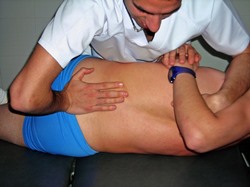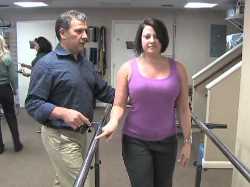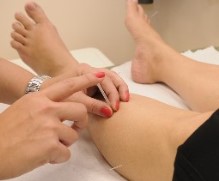How to Select a Physical Therapist School near Post 79356
 Obtaining a physical therapist degree near Post TX is an essential first step to starting a fulfilling career in the medical care industry. Physical therapists (PT) help people who have been incapacitated as a result of injury or illness regain mobility and function. But before they can practice and provide treatment for the rehabilitation of patients, they must get the appropriate training and education. A PT must also be licensed in all states, a large number requiring that the licensee receive a physical therapy degree from an accredited college. So before selecting a physical therapy school, it’s essential to investigate those you are thinking about to ensure they will provide a quality education and meet your state’s licensing requirements. What you do not want to do is enroll in a school just because it happens to be the nearest to your residence or it has the most affordable tuition. There are other important qualifications that need to be considered in addition to location and cost. But before we discuss what those qualifications are and what questions you should ask, we’ll cover what a physical therapist does and the options for education.
Obtaining a physical therapist degree near Post TX is an essential first step to starting a fulfilling career in the medical care industry. Physical therapists (PT) help people who have been incapacitated as a result of injury or illness regain mobility and function. But before they can practice and provide treatment for the rehabilitation of patients, they must get the appropriate training and education. A PT must also be licensed in all states, a large number requiring that the licensee receive a physical therapy degree from an accredited college. So before selecting a physical therapy school, it’s essential to investigate those you are thinking about to ensure they will provide a quality education and meet your state’s licensing requirements. What you do not want to do is enroll in a school just because it happens to be the nearest to your residence or it has the most affordable tuition. There are other important qualifications that need to be considered in addition to location and cost. But before we discuss what those qualifications are and what questions you should ask, we’ll cover what a physical therapist does and the options for education.
What Does a Physical Therapist Do?
 Physical therapists practice in diverse locations, including Post TX private practices, hospitals, rehabilitation centers, nursing homes and sports facilities. What the facilities all have in common is that they have the equipment for the diagnosis and rehabilitation treatment of patients. As previously stated, physical therapists help individuals that are suffering from a lack of mobility and frequently pain due to injury or illness. After patient diagnosis, they create a program of treatment to resolve the mobility issues and reduce or eliminate any pain. They also endeavor to stop any advancement of the disability. While the causes of disability requiring physical therapy are abundant, they include:
Physical therapists practice in diverse locations, including Post TX private practices, hospitals, rehabilitation centers, nursing homes and sports facilities. What the facilities all have in common is that they have the equipment for the diagnosis and rehabilitation treatment of patients. As previously stated, physical therapists help individuals that are suffering from a lack of mobility and frequently pain due to injury or illness. After patient diagnosis, they create a program of treatment to resolve the mobility issues and reduce or eliminate any pain. They also endeavor to stop any advancement of the disability. While the causes of disability requiring physical therapy are abundant, they include:
- Arthritis or Osteoporosis
- Motor vehicle accidents
- Head injuries.
- Cardiac arrest.
- Carpal Tunnel Syndrome.
- Fire injuries.
- Knee Replacement.
- Sciatica.
- Cerebral Palsy.
Licensed physical therapists practice in close association with other Post TX health specialists, including doctors, chiropractors, registered nurses and dentists. They can also supervise one or more physical therapy assistants who work under them assisting with diagnosing and treating their patients. One thing to keep in mind for anyone thinking about entering the physical therapy field, it is rather physically demanding. Physical therapists often lift heavy equipment as well as patients, and kneel, crouch and stand for prolonged periods of time on a daily basis.
Physical Therapy Degrees Available
 There are 3 physical therapy degrees available for individuals to enroll in at the graduate and undergraduate levels. Of these alternatives, the single degree that is attainable to practice as a physical therapist is the doctorate. Undergraduate degrees focus on either training students to become a physical therapy assistant (PTA) or preparing them to advance to the doctoral level. Following are brief summaries of degrees that are available in the Post TX area:
There are 3 physical therapy degrees available for individuals to enroll in at the graduate and undergraduate levels. Of these alternatives, the single degree that is attainable to practice as a physical therapist is the doctorate. Undergraduate degrees focus on either training students to become a physical therapy assistant (PTA) or preparing them to advance to the doctoral level. Following are brief summaries of degrees that are available in the Post TX area:
- Associate Degrees educate students to practice as physical therapy assistants, or may be the first step toward earning a more advanced degree. Applicants must have a high school diploma or GED to be accepted for enrollment. The degrees are usually provided by community colleges, and require two years to complete. Clinical training, which may be in the form of an internship is normally part of the course of study.
- Bachelor’s Degrees are designed as pre-physical therapy training to ready students to move up to the doctoral level. Although they are not required to be eligible for the doctoral program, they are an integral initial step to practicing as a PT. Similar to the majority of bachelor’s degrees, they generally take four years to complete and commonly include an internship program of a minimum of 500 hours.
- Doctorate Degrees are a requirement if you want to become a licensed practicing physical therapist. The degree program also must be accredited by the Commission on Accreditation in Physical Therapy Education (CAPTE). In addition to the bachelor’s degree, the doctoral takes 3 years to complete, making the total commitment 7 years in the majority of cases. Practical or clinical training is an intregal component in addition to the extensive classroom and lab instruction. Therefor the fulfillment of an internship is required, not just for graduation but in several states for licensing also.
The Doctor of Physical Therapy (DPT) has replaced the Master’s of Physical Therapy (MPT), which has been phased out and is no longer attainable in the United States. Some practicing physical therapists having a master’s or even a bachelor’s degree were “grandfathered” in before the current licensing mandate for a doctorate was implemented.
Physical Therapist Schools Online
 Although not as prevalent as the on-campus options, there are some accredited online physical therapy degrees available, more so at the graduate level. Because of the hands-on structure of the training, internships and clinical lab work are combined with the online classes. This requires that the student live close to the college campus or nearby a sponsored internship. Fortunately, the online segment of the curriculum can be accessed within the comfort and convenience of the student’s Post TX residence. Online schools are not only partially more accessible, but in many instances more affordable. Tuition can be somewhat less than comparable on campus alternatives, and expenses for commuting are minimized. And a number of the online programs are accredited by the CAPTE, assuring a quality education. These benefits can make the online alternative the ideal choice for those students that are dedicated enough to learn at home.
Although not as prevalent as the on-campus options, there are some accredited online physical therapy degrees available, more so at the graduate level. Because of the hands-on structure of the training, internships and clinical lab work are combined with the online classes. This requires that the student live close to the college campus or nearby a sponsored internship. Fortunately, the online segment of the curriculum can be accessed within the comfort and convenience of the student’s Post TX residence. Online schools are not only partially more accessible, but in many instances more affordable. Tuition can be somewhat less than comparable on campus alternatives, and expenses for commuting are minimized. And a number of the online programs are accredited by the CAPTE, assuring a quality education. These benefits can make the online alternative the ideal choice for those students that are dedicated enough to learn at home.
Topics to Ask Physical Therapy Programs
By now you probably have made a decision regarding several of your initial queries, like the type of physical therapy degree you want to attain, where you want to attend classes, and how much you can afford to invest in your education. But since there are so many PT colleges within the Post TX area and throughout Texas, you’ll have to research additional qualifications also so as to further reduce your list of school choices. Moreover, you want to make certain that you choose the college that is right for you. That’s why we have collected a list of critical questions that you need to ask the physical therapist programs you are thinking about. Ask all of the potential schools these questions prior to making a final decision.
Is the Physical Therapist School Accredited? Find out if the schools you are reviewing have received accreditation from a regional or a national organization. As earlier stated, if you are pursuing a doctoral degree the program must be accredited by the Commission on Accreditation in Physical Therapy Education (CAPTE). If you select an online college, it may also earn accreditation from the Distance Education and Training Council. It’s important that both the physical therapy school and program you select are accredited, not simply the school. Also, make sure that the accreditation is from a U.S. Department of Education acknowledged accrediting agency. In addition to guaranteeing that you obtain an excellent education, accreditation might be required for state licensing and even for getting student loans or financial assistance.
What is the College’s Standing? In addition to accreditation, it’s important that the college and program you select have exceptional reputations within the physical therapist profession. There are several ways you can research a PT program’s reputation, beginning with asking for references from employers that they place their graduates with. You can also check online reviews and rating services and ask the accrediting agencies for their reviews also. Get in touch with several Post TX physical therapy clinics or other health care facilities that you might have an interest in working for and ask if they can offer any advice about your program options. It might also be prudent to check with the Texas Attorney General and school licensing authority to see if any complaints have been filed against the schools.
What is the School’s Job Placement Percentage? There are a two significant statistics that you need to know about each of the physical therapy programs you are considering. One is their graduation rate. A lower rate may indicate that students dropped out due to dissatisfaction with the program, the instructors, or both. After the students have graduated, what percentage of them are being placed in jobs with the help of the school’s job placement program, particularly in the Post TX area? If a school has a high job placement rate, it’s an indication that its reputation within the healthcare field is good or perhaps excellent. It also confirms that the program has a large network of contacts to assist students obtain internships or employment upon graduation.
Does the College Prepare You For Licensing Requirements? It’s imperative that the college you enroll in furnishes both exceptional training and a course of study that satisfies the licensing requirements for Texas or the state where you will be working. In each state a passing score is needed on the National Physical Therapy Examination (NPTE) in addition to a degree from an accredited physical therapist college. Although licensing requirements fluctuate state by state for PTA and PT graduates, many states require a minimum number of clinical hours be performed and passing scores on supplemental tests.
Are Internships Sponsored? Ask if the physical therapist programs you are evaluating have partnerships with Post TX hospitals or clinics for internship programs. Not only are internships a terrific manner to receive hands on training in a clinical setting, they are also a requirement for the majority of PT programs and state licensing. As a supplemental benefit, they can assist students and graduates form professional connections in the Post medical community and assist with job placement after licensing.
What Size are the Classes ? Unless you are the kind of person that likes to sit way in the rear of the classroom or get lost in the crowd, you will undoubtedly prefer a smaller class size. Smaller classes permit more individual participation and personalized instruction. Ask the physical therapist colleges you are researching what the average student to teacher ratio is for their classes. If practical you may want to monitor one or more classes before making your ultimate determination. This will also give you an opportunity to talk with a few of the instructors and students to get their opinions regarding the pharmacy technician program as well.
Where is the College Located? For a lot of students, the physical therapist college they choose will need to be within driving distance of their Post TX residence. Those who have opted to attend classes online obviously will not have to trouble themselves with the location of the campus. However, the availability of local internships will be of importance. One thing to keep in mind is that if you decide to enroll in a college that is out of state or perhaps out of your local area, you may be required to pay a higher tuition. State colleges generally charge higher tuitions for out of state residents. And community colleges typically charge a higher tuition for those students that live outside of their districts.
Is Financial Support Provided? The majority of DPT colleges provide some type of financial assistance to their potential students. Ask if the colleges you are reviewing have a financial aid office and see what type of aid is obtainable. They at least should help in obtaining a student loan or any grants you may be eligible for. A number of physical therapy colleges provide scholarships, while others provide work programs. So before you eliminate a college because the tuition is too expensive, find out what financial assistance might be available.
Can the College Accommodate your Schedule? And last you need to confirm that the physical therapist program you ultimately select can offer the class schedule you need. This is particularly essential if you choose to continue working while attending school. If you must schedule evening or weekend classes in the Post TX area, make sure that they are available. If you can only enroll on a part-time basis, check if that is an option and how many courses or credit hours you would need to carry. Also, ask what the protocol is for making up any classes that you may miss because of illness, work or family emergencies.
Earning Your Physical Therapy Degree near Post Texas?
If you are planning on attending a Physical Therapy School in the Post TX area, the following information may prove to be both interesting and educational regarding the location of your future Alma Mater.
Post, Texas
The land belonged to John Bunyan Slaughter, as it was on his U Lazy S Ranch.[4] In 1906, Slaughter sold it to Charles William (C. W.) Post, the breakfast cereal manufacturer, who founded "Post City" as a utopian colonizing venture in 1907. Post devised the community as a model town.[5][6] He purchased 200,000 acres (810 km2) of ranchland and established the Double U Company to manage the town's construction. The company built trim houses and numerous structures, which included the Algerita Hotel, a gin, and a textile plant. They planted trees along every street and prohibited alcoholic beverages and brothels. The Double U Company rented and sold farms and houses to settlers. A post office began in a tent during the year of Post City's founding, being established (with the name Post) July 18, 1907, with Frank L. Curtis as first postmaster.[7] Two years later, the town had a school, a bank, and a newspaper, the Post City Post, the same name as the daily in St. Louis, Missouri. The Garza County paper today is called the Post Dispatch. The railroad reached the town in 1910. The town changed its name to "Post" when it incorporated in 1914, the year of C. W. Post's death. By then, Post had a population of 1000, 10 retail businesses, a dentist, a physician, a sanitarium, and Baptist, Methodist, and Presbyterian churches.
Postex Cotton Mills began production in 1913 with 250 employees. When the Post interests sold the business in 1945 to Ely and Walker Dry Goods Company of St. Louis, the plant was producing six million yards of cloth a year and employed 375 workers who manufactured Postex cotton sheets and Garza pillow cases. Ely and Walker sold Postex in 1955 to Burlington Industries, the world's largest textile manufacturer at that time. By 1973, the company employed 450 persons. The mill has since closed.
Oilfield service companies have been important to the economy, as have farming and ranching. In 1989, Post had two libraries, a hospital, a nursing home, an airport, the Post Dispatch (founded 1926), and 90 businesses. The population reached 3,400 in 1928, declined to 2,000 in 1940, and increased to 3,100 during the 1950s. With the development of the local oil industry, the town's population attained its highest level of 4,800 in 1964. The 1980 census showed a population of 3,864, but by 1988, the Texas Almanac reported 4,162. In 1990, the population was 3,768.
Enroll in the Right Physical Therapy School near Post TX
Choosing the best physical therapist college is an important first decision you have to make to launch a rewarding career in the medical field. As we have addressed in this article, the PT or DPT degree program and school you select should both have outstanding reputations and accreditation. But there are other critical questions that you need to ask pertaining to your school of choice also. As you begin your search for a physical therapy school, bear in mind that a number of factors will lead you toward your final decision. You may want to go to different schools to view their facilities and speak to active DPT students. While there, ask yourself this important question: will this school help me reach my goal of becoming a practicing licensed physical therapist? By adhering to our list of additional questions, you will be able to narrow down the field so you can make the ideal selection. And with the necessary training and education, you can accomplish your dream of becoming a licensed physical therapist in Post TX.
A Few More Interesting Locations in Texas
